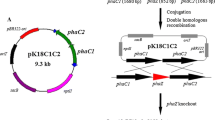Abstract
Twenty natural amino acids were investigated as carbon sources for biosynthesis of poly(3-hydroxyalkanoate) (PHA) by Ralstonia eutropha in media free of inorganic nitrogen, phosphate, or magnesium. First, the effect of limiting nitrogen, phosphate, and magnesium was investigated on the metabolism of l-leucine. Nitrogen-limited media have been widely used to stimulate PHA accumulation, but phosphate-free media lead to higher accumulation. This is because amino acids can act as nitrogen sources, leading to preferential cell growth over PHA accumulation. Magnesium-free conditions don’t show a significant effect on accumulation of PHA. When Ralstonia eutropha was cultivated in the presence of natural amino acids l-leucine, l-isoleucine, l-phenylalanine, and l-tyrosine in media free of nitrogen, phosphate, and magnesium, the PHA content was high, over 40 % of dry weight. Accumulation of PHA on supplementation with mixed substrates of l-leucine and various other amino acids was investigated in nitrogen-, phosphate-, and magnesium-free medium. Culturing with most mixed substrates led to accumulation of PHA, but some led to low or no PHA yield in spite of high PHA yield when metabolized from l-leucine alone. l-cysteine as a sole carbon source showed a unique feature, in that cell growth was significantly preferred over PHA accumulation. A mixed substrate of l-leucine and l-cysteine provided high PHA accumulation because of the combination of PHA accumulation due to l-leucine and cell growth due to l-cysteine. When glucose was used instead of l-leucine in a mixed substrate with l-cysteine, the PHA content was much lower because l-cysteine acts as an inhibitor of glucose metabolism. These results showed that the precise combination of carbon sources is an important factor in accumulation of PHA.






Similar content being viewed by others
References
Holmes PA (1985) Phys Technol 16:32
Doi Y, Tamaki A, Kunioka M, Soga K (1987) J Chem Soc Chem Commun 1635
Doi Y, Tamaki A, Kunioka M, Soga K (1998) Appl Microbiol Biotechnol 28:330
Mitomo H, Morishiota N, Doi Y (1993) Macromolecules 26:5809
Yoshie N, Menju H, Sato H, Inoue Y (1995) Macromolecules 28:6516
Yoshie N, Fujiwara M, Kasuya K, Abe H, Doi Y, Inoue Y (1993) Macromolecules 26:5809
Yoshie N, Fujiwara M, Kasuya K, Abe H, Doi Y, Inoue Y (1999) Macromol Chem Phys 200:977
Mothes G, Schnorpfeil C, Ackmann JU (2007) Eng Life Sci 7:475
Cavalheiro JMBT, Dealmeida MCMD, Grandfils C, Dafonseca MMR (2009) Process Biochem 44:509
Zhu C, Nomura CT, Perrotta JA, Stipanovic AJ, Nakas JP (2010) Biotechnol Prog 26:424
Huijberts GNM, Eggink G, Waard P, Huisman GW, Witholt B (1992) Appl Environ Microbiol 58:536
Ashby RD, Solaiman DKY, Foglia TA (2005) Biomacromolecules 6:2106
Cromwick AM, Foglia TA, Lenz RW (1996) Appl Microbiol Biotechnol 46:464
Ashby RD, Foglia TA (1998) Appl Microbiol Biotechnol 49:431
Solaiman DKY, Ashby RD, Foglia TA (2001) Appl Microbiol Biotechnol 56:664
Solaiman DKY, Ashby RD, Foglia TA (2002) Curr Microbiol 44:189
Miura T, Ishii D, Nakaoki T (2013) J Polym Environ 21:760
Nakamura K, Goto Y, Yoshie N, Inoue Y, Chujo R (1992) Int J Biol Macromol 14:117
Nakamura K, Goto Y, Yoshie N, Inoue Y (1992) Int J Biol Macromol 14:321
Fujita M, Nakamura K, Kuroki H, Yoshie N, Inoue Y (1993) Int J Biol Macromol 15:253
Fujita M, Nakamura K, Ohta O, Kuroki H, Yoshie N, Inoue Y (1994) Macromol Chem Phys 195:3699
Kimura H, Mouri K, Takeishi M, Endo T (2003) Bull Chem Soc Jpn 76:1775
Anderson AJ, Dawes EA (1990) Microbiol Rev 54:450
Brandl H, Gross RA, Lenz RW, Fuller RC (1990) Adv Biochem Eng Biotechnol 41:77
Doi Y (1990) Microbial polyesters. Verlag Chemie, New York
Ryu HW, Hahn SK, Chang YK, Chang HN (1997) Biotehnol Bioeng 55:28
Hee WR, Sei KH, Yong KC, Ho NC (1997) Biotechnol Bioeng 55:28
Longan S, Min J, Ho NC (2003) Biotechnol Lett 25:1415
Squio CR, Marangoni C, Vecchi CSD, Aragao GMF (2003) Appl Microbiol Biotechnol 61:257
Acknowledgments
This work was partially supported by a Grant-in-Aid for Scientific Research, MEXT (No. 24550179). In addition, financial support from a research fund at Ryukoku University is gratefully acknowledged.
Author information
Authors and Affiliations
Corresponding author
Rights and permissions
About this article
Cite this article
Sakamoto, M., Kimura, Y., Ishii, D. et al. Biosynthesis of Poly(3-hydroxyalkanoate) from Amino Acids in Medium with Nitrogen, Phosphate, and Magnesium, or Some Combination of These Nutrients. J Polym Environ 22, 488–493 (2014). https://doi.org/10.1007/s10924-014-0656-9
Published:
Issue Date:
DOI: https://doi.org/10.1007/s10924-014-0656-9




